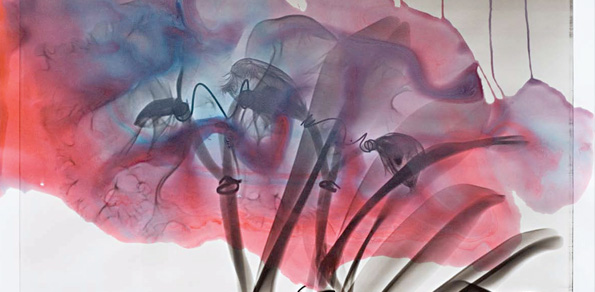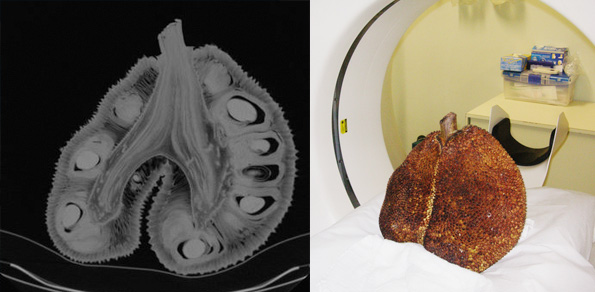
An American’s Amazonian X-Ray
Jungle Drums Online
By Zaira Brilhante, April 8, 2010
| Jungle Meets the Man Behind the Photos that Look Deep into the Undergrowth When you come across Steve Miller’s series Health of the Planet, if you’re Brazilian, it is impossible not to think of the idiom “an x-ray of the situation”. It usually means a very deep analysis. In this case, it happens through the art. The most recent work of the artist consists in taking elements from the Amazon to put them under the precision of x-ray photos. “The Brazilian rainforests are the lungs of our planet and I decided to give Brazil a medical check-up by taking x-rays of these lungs through the flora and fauna of the Amazon”, explains Miller, who fell in love with the country when he first visited in 2004. “I had my first encounter with a Jaca (bread fruit) on Ilha Grande in Angra dos Reis, near Rio. Walking through the Atlantic rainforest I saw these enormous and strange fruits and wondered what they were. The Jaca was my eureka moment. I knew I could find out what was inside by not cutting into the fruit but taking an x-ray of the plant”. The very post-modern mixture of the organic with the scientific tools creates beautiful compositions, full of symbolism and fluidity. Miller applies silk-screen strokes to some of his pieces, to enhance the ephemerality of these images. Still, most of his work lies in the black and white of the x-rays. The exhibition, with works on paper, prints and one glass plate sculpture, is open for the public from the 15th of April to 8th of May, in the Gallery Maya, West London. Some of Steve Miller’s work can also be viewed on his website. |

| When and how did you decide to work with Amazon elements?On my first visit to Brazil in 2004 I had my first encounter with a Jaca (bread fruit) on Ilha Grande, in Angra dos Reis, near Rio. Walking through the Atlantic rain forest I saw these enormous and strange fruits and wondered what they were.Was it love at first sight? Truth be it known, yes. I fell in love with Brazil on this first visit and was looking for my excuse to return as a working artist. The Jaca was my eureka moment. I knew I could find out what was inside by not cutting into the fruit but by taking an x-ray of the plant. On rare occasions, there are two Jaca on one stem and they look like lungs. But Health of the Planet is a recent project… At that point I concocted my scheme to return to Brazil every year since then. The Brazilian rain forests are the lungs of our planet and I decided to give Brazil a medical check-up by taking x-rays of these lungs through the flora and faun of the Amazon. Thus, was born this project “Health of the Planet”. The project involved actually bringing these plants and animals to a hospital in Brazil where, to an MRI machine (see images above). Do you consider your work post-modern? Labels like modern and post-modern are so confusing for the person not immersed in the nomenclature of art speak. Officially, we are in the Post-Modern moment where, in the Western art world, the linear successions of sequential styles and art movements have morphed into a time of inter-discipline, cross cultural and multi media in all aspects of, what is now thought of as, a World culture. By this definition, I’m Post-Modern in that my work involves a collaboration with another discipline, formerly outside the world of fine art (science), that has not been pursued as vigorously since the time of Leonardo. What’s more of interest to me is to work with a universal visual language which is the international language of our time, technology. But we can say that technology had invaded the fine arts world much earlier, don’t you agree? So how would you define this exhibition? Tell us more about the techniques you applied to it. |

